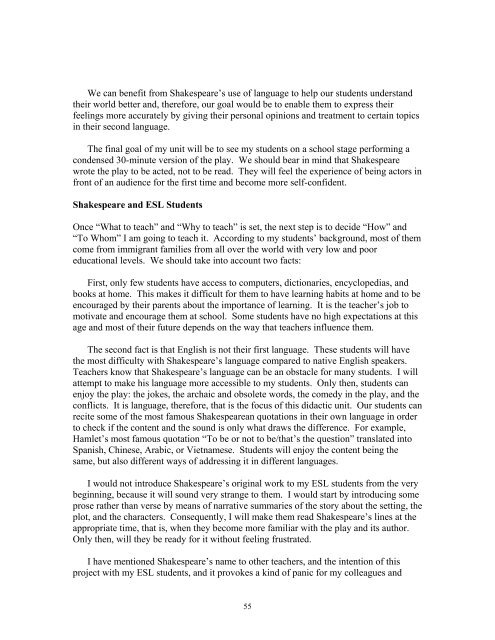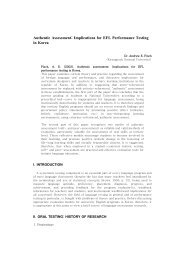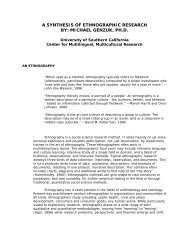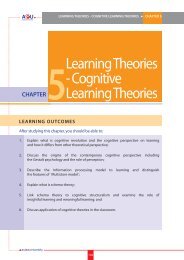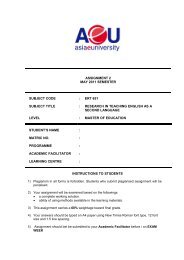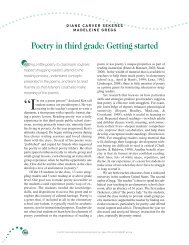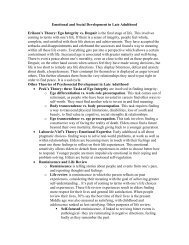Teaching Romeo and Juliet to ESL Students in ... - learningdomain
Teaching Romeo and Juliet to ESL Students in ... - learningdomain
Teaching Romeo and Juliet to ESL Students in ... - learningdomain
You also want an ePaper? Increase the reach of your titles
YUMPU automatically turns print PDFs into web optimized ePapers that Google loves.
We can benefit from Shakespeare’s use of language <strong>to</strong> help our students underst<strong>and</strong>their world better <strong>and</strong>, therefore, our goal would be <strong>to</strong> enable them <strong>to</strong> express theirfeel<strong>in</strong>gs more accurately by giv<strong>in</strong>g their personal op<strong>in</strong>ions <strong>and</strong> treatment <strong>to</strong> certa<strong>in</strong> <strong>to</strong>pics<strong>in</strong> their second language.The f<strong>in</strong>al goal of my unit will be <strong>to</strong> see my students on a school stage perform<strong>in</strong>g acondensed 30-m<strong>in</strong>ute version of the play. We should bear <strong>in</strong> m<strong>in</strong>d that Shakespearewrote the play <strong>to</strong> be acted, not <strong>to</strong> be read. They will feel the experience of be<strong>in</strong>g ac<strong>to</strong>rs <strong>in</strong>front of an audience for the first time <strong>and</strong> become more self-confident.Shakespeare <strong>and</strong> <strong>ESL</strong> <strong>Students</strong>Once “What <strong>to</strong> teach” <strong>and</strong> “Why <strong>to</strong> teach” is set, the next step is <strong>to</strong> decide “How” <strong>and</strong>“To Whom” I am go<strong>in</strong>g <strong>to</strong> teach it. Accord<strong>in</strong>g <strong>to</strong> my students’ background, most of themcome from immigrant families from all over the world with very low <strong>and</strong> pooreducational levels. We should take <strong>in</strong><strong>to</strong> account two facts:First, only few students have access <strong>to</strong> computers, dictionaries, encyclopedias, <strong>and</strong>books at home. This makes it difficult for them <strong>to</strong> have learn<strong>in</strong>g habits at home <strong>and</strong> <strong>to</strong> beencouraged by their parents about the importance of learn<strong>in</strong>g. It is the teacher’s job <strong>to</strong>motivate <strong>and</strong> encourage them at school. Some students have no high expectations at thisage <strong>and</strong> most of their future depends on the way that teachers <strong>in</strong>fluence them.The second fact is that English is not their first language. These students will havethe most difficulty with Shakespeare’s language compared <strong>to</strong> native English speakers.Teachers know that Shakespeare’s language can be an obstacle for many students. I willattempt <strong>to</strong> make his language more accessible <strong>to</strong> my students. Only then, students canenjoy the play: the jokes, the archaic <strong>and</strong> obsolete words, the comedy <strong>in</strong> the play, <strong>and</strong> theconflicts. It is language, therefore, that is the focus of this didactic unit. Our students canrecite some of the most famous Shakespearean quotations <strong>in</strong> their own language <strong>in</strong> order<strong>to</strong> check if the content <strong>and</strong> the sound is only what draws the difference. For example,Hamlet’s most famous quotation “To be or not <strong>to</strong> be/that’s the question” translated <strong>in</strong><strong>to</strong>Spanish, Ch<strong>in</strong>ese, Arabic, or Vietnamese. <strong>Students</strong> will enjoy the content be<strong>in</strong>g thesame, but also different ways of address<strong>in</strong>g it <strong>in</strong> different languages.I would not <strong>in</strong>troduce Shakespeare’s orig<strong>in</strong>al work <strong>to</strong> my <strong>ESL</strong> students from the verybeg<strong>in</strong>n<strong>in</strong>g, because it will sound very strange <strong>to</strong> them. I would start by <strong>in</strong>troduc<strong>in</strong>g someprose rather than verse by means of narrative summaries of the s<strong>to</strong>ry about the sett<strong>in</strong>g, theplot, <strong>and</strong> the characters. Consequently, I will make them read Shakespeare’s l<strong>in</strong>es at theappropriate time, that is, when they become more familiar with the play <strong>and</strong> its author.Only then, will they be ready for it without feel<strong>in</strong>g frustrated.I have mentioned Shakespeare’s name <strong>to</strong> other teachers, <strong>and</strong> the <strong>in</strong>tention of thisproject with my <strong>ESL</strong> students, <strong>and</strong> it provokes a k<strong>in</strong>d of panic for my colleagues <strong>and</strong>55


